|
A GLOSSARY of MILLED BANDS
|
|
| How to Post Photos |
REGISTER (click here)
|
|
A GLOSSARY of MILLED BANDS
|
|
| How to Post Photos |
REGISTER (click here)
|

|
 SMP Silver Salon Forums SMP Silver Salon Forums
  American Silver before sterling American Silver before sterling
  coin silver? coin silver?
|
| next newest topic | next oldest topic |
| Author | Topic: coin silver? |
|
tmockait Posts: 963 |
  
I bought this spoon on Antique Row in Philadelphia. It comes from an estate sale and bore a handwritten note: "Mama bought this before her wedding in 1856." I thought the only discernible mark is the number "31" punched into the back of the handle. There were letters to the right of the 31, but they are now almost totally effaced. I can only make out a couple of the letters and cannot get them to show up in a photo. They clearly do not spell the word "sterling." They may be AT. co. and since the last letter is clearly a capital "Y", perhaps NY. Any ideas about this spoon would be greatly appreciated. Thanks, IP: Logged |
|
Brent Posts: 1507 |
  
Hi Tom, Well, you've been handling a few pieces of coin now; how does this piece compare to your known coin silver spoons? Does it look and feel "right"? I don't think we will be able to tell from the pictures you posted, but you might from just handling it. As you know, it could be: coin silver Nothing seems obvious from the pictures, thought he big number makes me think of pieces I have seen by Whiting from their early days as a manufacturer. Anyway, you will have to make the call, based on what you have learned. Let us know what you decide! Brent IP: Logged |
|
tmockait Posts: 963 |
  
Thanks Brent. Based on what archaeologists sometimes call the "provinence" of the piece (context in which it was found), pre-1856 sounds convincing. It has the feel of solid sivler, so I have ruled out plate, nickel silver, etc. I was hoping one of you experts could recognize something from the pattern, style, etc. I will check the Whiting angle. I now buy spoons with two considerations in mind: how does the piece look?; and how much of a challenge will it be to figure out the marks. Regards, [This message has been edited by tmockait (edited 01-11-2006).] IP: Logged |
|
outwest Posts: 390 |
  
I am pretty sure your spoon is coin. I have a very similar spoon, but I think this design was common back then. My spoon is from 1790's. Of that I am fairly sure as EK (the monogram) was married in 1792. I don't know how long these spoons were made, though. Yours seems to bend the same direction at the tip as mine does. Mine also has a second monogram on the back that I believe is the mother of EK, so mine could be a bit older, even. I haven't researched the maker yet. Maybe I will do that now. I'll let you know what I find out, if anything. IP: Logged |
|
wev Moderator Posts: 4121 |
  
Actually, Outwest, yours are closer to 1890 than 1790. Fessenden & Brother (William Bodfish and Thomas Francis Fessenden) was at 119 Washington Street in Boston c 1860-1864. IP: Logged |
|
outwest Posts: 390 |
  
hmm, very curious. I can't find Fessenden Bros. that aren't mid 19th. But, the monogram matches the one on the Theophylus Bradbury spoons. I wish I could find a picture of the Fessenden Bros. mark to know if this is a mid 19th century spoon or late 18th century. But, EK was dead by the early 1800's! I haven't seen older American spoons with numbers on them. Is there any way you can try to show the rubbed off mark? IP: Logged |
|
wev Moderator Posts: 4121 |
  
Oh, there's no doubt the spoon is mid 19th century. The double swell was the last manifestation of the fiddleback before patterned goods (bleck) became de rigueur. It is not surprising to find nearly identical monograms; the style of such lingered for many years and people had new goods engraved to match old. IP: Logged |
|
outwest Posts: 390 |
  
Wev, here is the another spoon with the EK monogram and the spoon mark for Theophylus Bradbury. The monogram looks like it's made by the same hand to me: I think there is an earlier Fessenden Bros. There must be or it wouldn't make any sense at all because EK died in about 1830. She married in 1792. Do you think the engraving looks like the same hand? Maybe they are from the early 1800's? Or, maybe the monogramming was done after she was dead. LOL. How long was that style of spoon made? IP: Logged |
|
wev Moderator Posts: 4121 |
  
Yes, they look quite close, but I suspect they were done later. I have seen quite a lot of Bradbury's work (tracing his family got me started on my blasted makers project) and he was consistently a better engraver than that. And you would be hard pressed to find a double swell that dated earlier than 1840. Ain't mysteries grand? IP: Logged |
|
outwest Posts: 390 |
  
I always thought the monogramming was rather crude. Most of the monograms are quite elegant. These look amateurish. I wonder if someone in the family did that in the late 1800's when they were identifying the spoons (incorrectly, it seems)? I have a pile of spoons that have been dated by an ancestor and identified as certain peoples in a handwritten letter from 1880. The spoons have been handed down from mother to daughter since EK's mother. I betcha someone thought they were doing a favor and monogrammed them...wrongly. What else could explain it? IP: Logged |
|
tmockait Posts: 963 |
  
"There is no doubt the spoon is mid-19th c." Wev, whose spoon, mine or Outwests? IP: Logged |
|
wev Moderator Posts: 4121 |
  
Outwest's, though yours could well be. IP: Logged |
|
outwest Posts: 390 |
  
But, Tmokat's spoon has more of an angle then my pseudo-early spoon (now I've got to get them all out and try to get them in the right order!). So, since his is more angular in the handle wouldn't that indicate an earlier date? IP: Logged |
|
outwest Posts: 390 |
  
Here's another one like yours, Tmockait: I was just reading about the coffin ends, trifid, and the fiddle ends, the shoulders, etc. I'm still learning, obviously! It just goes to show you that you can't rely on the monograms. I hesitate to mention what I thought was the date on this spoon, but I thought it was a little before 1850, but I can't find 'HP Elias' anywhere to confirm that. I thought the shoulders got bigger as time went on and these are pretty big, so who knows how old it is. This spoon looks a little more like yours. Yours looks like the note could be correct that came with it. I have never found any really old silver in the antiques shops around me. It's mostly turn of the century things. IP: Logged |
|
tmockait Posts: 963 |
  
The challenge of deciphering this piece is why I bought it. I believe the answer lies in the almost effacet word or letters on the back of the handle. I tried using tissue paper and a pencil to see if I could trace them, but no luck. Anyone have any other suggestions for how to raise a mark that is still there but not visible even with a magnifying glass? Tom IP: Logged |
|
wev Moderator Posts: 4121 |
  
Have you tried sooting it with a cheap candle and carefully rubbing just the highpoints? It may give you enough contrast for a picture. IP: Logged |
|
tmockait Posts: 963 |
  
No, but can you explain a bit more? I am not sure I follow what exactly I should do. Thanks, IP: Logged |
|
wev Moderator Posts: 4121 |
  
Light one of those little birthday cake candles and hover the handle over it, so the mark area gets sooty. Very carefully and gently, rub the area with a piece of hard, smooth paper. This should clear the soot off just the high points and leave it in the reserve. You can then try a photo. If that does not work, you can lay a piece of tape (the clear kind) over the area, burnish down, then lift it off and tape it down to a white piece of paper. None of this will hurt the spoon in the least, though you might burn your finger if not careful. IP: Logged |
|
t-man-nc Posts: 327 |
  
Another Givaway on coin silver is the shoulders, they didn't show up much before 1815 til 1820, The Doubleswell of Fessenden's has the shoulders,the Bradbury does not. "Smaug" IP: Logged |
|
Polly Posts: 1970 |
  
What does "double swell" mean? Does it refer to the shape of the fiddle? Or maybe the bit at the very tip of the handle where it turns up? IP: Logged |
|
wev Moderator Posts: 4121 |
  
The shape of the handle. IP: Logged |
|
Polly Posts: 1970 |
  
Thanks! I wondered what that was called. IP: Logged |
|
swarter Moderator Posts: 2920 |
  
The Fessenden Brothers advertised under that name in Boston in 1854 (they are also listed in Providence, RI, but that is probably in error, as there was another Fesenden firm there as well). Henry P. Elias was in Cincinnati 1855-68. These two spoons are quite different and absolutely characteristic of their respective areas: the Fessenden spoon style of double-swell fiddle is found in Boston and throughout New England and on up through Maine into the Canadian Maritimes in the 1850's and 60's. The style of fiddle on the Elias spoon is strictly midwestern in the same period - Ohio, Kentucky, Missouri, Indiana, etc., all throughout the Ohio Valley. These forms have been dubbed "Boston Fiddles" or "New England Fiddles" and "Ohio Valley Fiddles" or "Midwestern Fiddles." By this time industrialization had progressed to the point that Eastern manufacturers were able to ship large numbers of spooons and other items to sellers in the West and South. New England made spoons of this style turn up occasionally having been marked and sold by dealers outside of New England (some sold in the south and midwest), but these have been bought in for resale or made to match as replacements. A few Eastern makers (like Peter Krider in Philadelphia) made midwestern fiddles, but these almost certainly were made for "export" to midwestern sellers and not sold locally. The "EK" initials do look like the same hand, so maybe there was another EK a generation or two later. The spoon that started this thread is sufficiently generic that there is nothing in particular geographically or chronologically distinctive about it that would help deduce its origin. [This message has been edited by swarter (edited 01-14-2006).] IP: Logged |
|
outwest Posts: 390 |
  
Well, EK was from Boston. The monogram on the Elias spoon was from Cincinnati (where on earth did you find that? I looked everywhere!). The Elias dates match the monogram time period. The old spoons from Ohio all seem to have very large handles in comparison to others. It is rather curious that the EK monogram is the same on the two spoons that are several decades apart in time period. As I said, they must have been done later. Swarter, Now I am curious to see what the candle experiment turns up on Tmokait's spoon. IP: Logged |
|
ahwt Posts: 2334 |
  
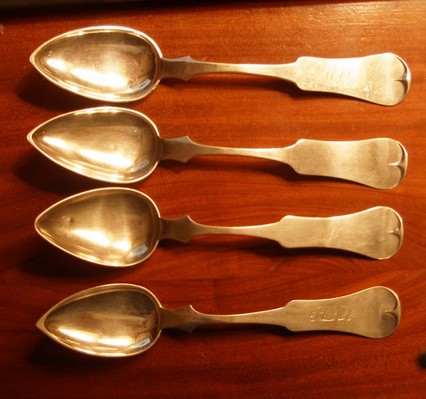 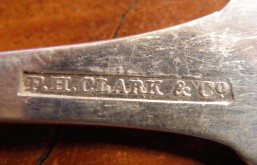 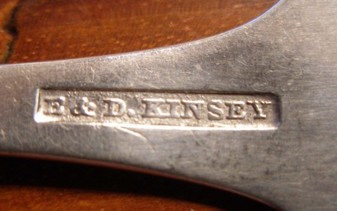 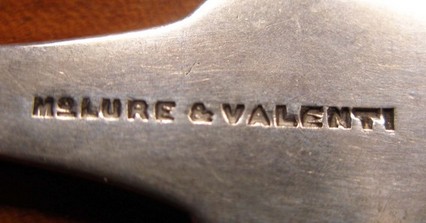 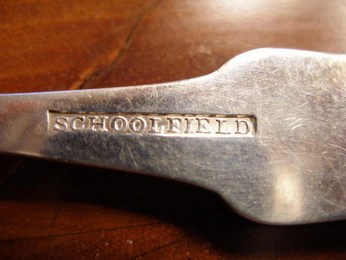 Above are four spoons in the fiddle pattern that are often found in Kentucky, Ohio and Missouri. From top down they are marked F. H. Clark and Co., E. & D. Kinsey, Mclure & Valenti, and Schoolfield. As F. H. Clark is a well known Memphis, Tennessee retailer one wonders why they were selling Midwestern style spoons. Boultinghouse notes in his book “Silversmiths of Kentucky” that F. H. Clark may have worked in Kentucky and perhaps that is where he found a fondness for this pattern. The Kinsey’s were from Cincinnati, McLure and Valenti from Kentucky and Schoolfield was from Missouri. I recently saw the “Silver in Georgia” exhibit at the Georgia Museum of Art in Athens, Georgia and saw spoons of this same style attributed to George Sharp, Jr. of Atlanta, Georgia. As Clark, George Sharp, Jr. worked in Kentucky and these spoons may be a carryover of the style he became familiar with while he was in that state. The spoons in the exhibit were heavily decorated and he may have done that addition thinking that it would please the new customers. The Georgia Museum of Art has a Decorative Arts Symposium in February and it would be interesting if they discuss what influence he had on styles in Georgia. I might add that the exhibit in the Georgia Museum of Art is small but very interesting. They have a very interesting display of silver objects that were given as agricultural fair premiums. In 1870 the State of Georgia spent over $50,000 for premiums and that followed a long tradition of providing excellent objects of silver to the winners of the various categories. Most of the premiums I am familiar with were from Missouri State fairs and they did not come close to the value of those given in Georgia. IP: Logged |
|
outwest Posts: 390 |
  
Do you notice how Tmokait's fiddle handle is shorter and the length between bowl and handle is longer then any of these others? Would that be an indication of where it was made? Since we are showing variations of these spoons here's 2 more with those bumps on the end(what do you call them?)along with a coffin ended spoon and another plain one. The coffin end and the plain one both have very small shoulders beneath the bowls. Does that mean they are probably older? From top to bottom they are: IP: Logged |
|
tmockait Posts: 963 |
  
I tried Wev's candle trick without much luck. I can make out "st" at the beginning and "ly" at the end. Would Stauffer & Harley of Philadelphia (where I got the spoon) be a possiblity? Thanks, IP: Logged |
|
ahwt Posts: 2334 |
  
Louise Belden has in her book “Marks of American Silversmiths in the Ineson-Bissell Collection” an illustrated glossary of spoon terms. For the fiddle she lists: Fiddle Your top spoon would be broad fiddle and your second would be coffin fiddle. The last two are “tipped” one being a fiddle tipped and the other a double-swell. She does not seem to make a distinction between the double-swell with a broad top and one with a narrower top. It is the broad top one that often is found in the mid-west and Kentucky. Not shown is the fiddle and that simply is the same as the coffin fiddle except that the end is rounded as in the broad fiddle. For the oval fiddle the sides bows out slightly. IP: Logged |
|
ahwt Posts: 2334 |
  
 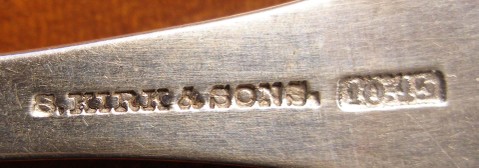 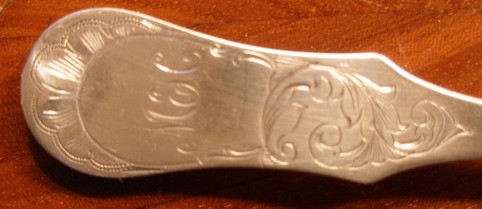 Above is a Kirk and Sons spoon in fiddle pattern and except for the bowl is very similar to those found in Kentucky or the Midwest. The engraving on the handle softens the effect of the well-defined fiddle, but nevertheless it is there. The above spoon has nothing to do with the fiddle pattern. It is an oval thread from Tennessee that has added engraving much like the Kirk spoon. I was just curious if anyone knew whether or not this form was engraved at the time of manufacture or whether the owner of it just decided to have it done locally. IP: Logged |
|
t-man-nc Posts: 327 |
  
Remember that Belden was defining what was specifically contained within the Winterthur collection she was writting about. "Smaug" IP: Logged |
|
bascall Posts: 1629 |
  
quote: I don't doubt for a moment that swarter has a perfectly good reference for Elias, but in case anyone is interested here is another: Worldwide Masonary Directory 1860, Henry P Elias, wholesale dealer in watches and jewelery, Cincinnati, Ohio. IP: Logged |
All times are ET | next newest topic | next oldest topic |
  |
|
Ultimate Bulletin Board 5.46a
|
1. Public Silver Forums (open Free membership) - anyone with a valid e-mail address may register. Once you have received your Silver Salon Forum password, and then if you abide by the Silver Salon Forum Guidelines, you may start a thread or post a reply in the New Members' Forum. New Members who show a continued willingness to participate, to completely read and abide by the Guidelines will be allowed to post to the Member Public Forums. 2. Private Silver Salon Forums (invitational or $ donation membership) - The Private Silver Salon Forums require registration and special authorization to view, search, start a thread or to post a reply. Special authorization can be obtained in one of several ways: by Invitation; Annual $ Donation; or via Special Limited Membership. For more details click here (under development). 3. Administrative/Special Private Forums (special membership required) - These forums are reserved for special subjects or administrative discussion. These forums are not open to the public and require special authorization to view or post. |
|
copyright © 1993 - 2022
SM Publications
All Rights Reserved. Legal & Privacy Notices |